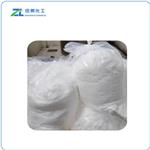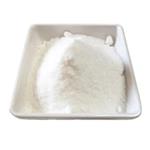Description
1,3-Diamino-2-propanol (DAP), also known as 2-hydroxy-1,3-diaminopropane, is a white to yellowish low melting solid. Keep in a cool, well-ventilated place. Avoid prolonged storage periods. Store under inert gas, in a tightly sealed container and at ambient temperatures. 1,3-Diamino-2-propanol is incompatible with acids and strong oxidizing agents and should not be stored or handled in their vicinity.
Chemical Properties
white to yellowish low melting solid
Uses
- 1,3-Diamino-2-propanol is a versatile bidentate diamine ligand which is used in the synthesis of a variety of organometallic compounds.
- It is a precursor to synthesize the fluorogenic dsDNA binder, N1,N3-bis(4-amidinophenyl)propane-1,3-diamine (BAPPA).
- It can also be used as a branching unit in the synthesis of peptide dendrimers.
Application
1,3-diamino-2-propanol (DAPL), a close analog of 1,3-diaminopropane, is an indirect inhibitor of ornithine decarboxylase (ODC). It is administered orally and inhibits ODC activity in the livers of partially hepatectomized rats[1]. It contains amine and hydroxyl groups. Therefore, it can be crosslinked with the carboxyl group via covalent and hydrogen bonds and has been investigated as a diamine monomer in the aqueous phase to fabricate the high-performance RO membrane[2].
Preparation
1,3-Diamino-2-propanol is synthesized by reacting Epichlorohydrin with ammonia in alkaline
environment by adding sodium hydroxide. Afterwards, the product
undergoes a series of purification steps.

Hazard
1,3-Diamino-2-propanoli is a hazardous chemical.
H302 (66.17%): Harmful if swallowed [Warning Acute toxicity, oral]. H314 (66.92%): Causes severe skin burns and eye damage [Danger Skin corrosion/irritation]. H315 (33.08%): Causes skin irritation [Warning Skin corrosion/irritation]. H317 (66.17%): May cause an allergic skin reaction [Warning Sensitization, Skin]. H318 (66.17%): Causes serious eye damage [Danger Serious eye damage/eye irritation]. H319 (33.08%): Causes serious eye irritation [Warning Serious eye damage/eye irritation]. H335 (34.59%): May cause respiratory irritation [Warning Specific target organ toxicity, single exposure; Respiratory tract irritation.
Purification Methods
Dissolve it in an equal amount of water, shake it with charcoal and distil it at 68o/0.1mm. The distillate solidifies. It is too viscous to be distilled through a packed column. [Beilstein 4 IV 1694.]
References
[1] Raunio H, et al. The inhibition of induction of microsomal monooxygenase activity by 1,3-diamino-2-propanol, an inhibitor of ornithine decarboxylase. Biochemical and Biophysical Research Communications, 1979; 9: 285–290.
[2] Su T, et al. A novel polyamide thin-film nanocomposite reverse osmosis membrane constructed by a 3D multi-layer graphene oxide assembled with 1,3-diamino-2-propanol. Journal of Membrane Science, 2023; 681: 121773.





